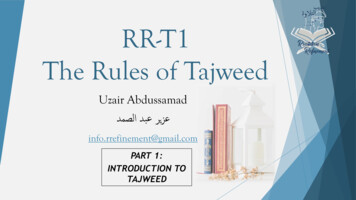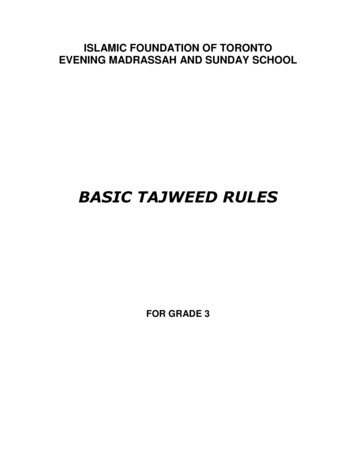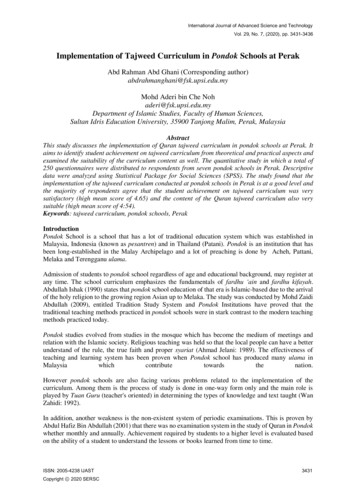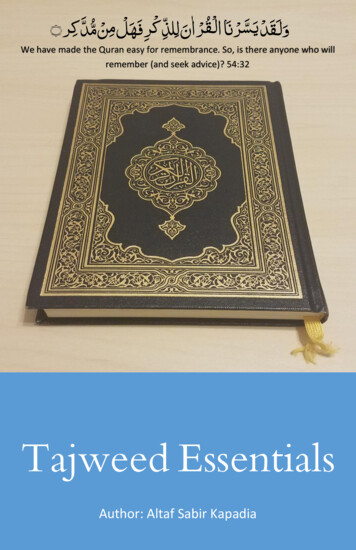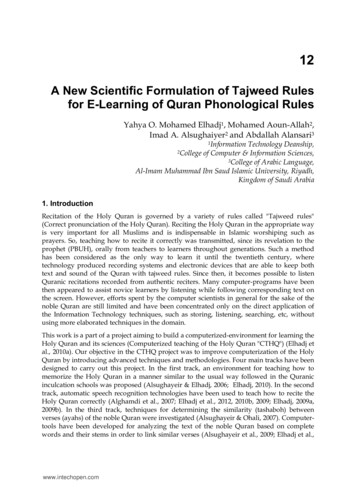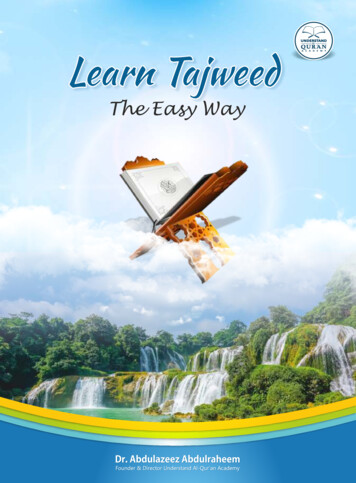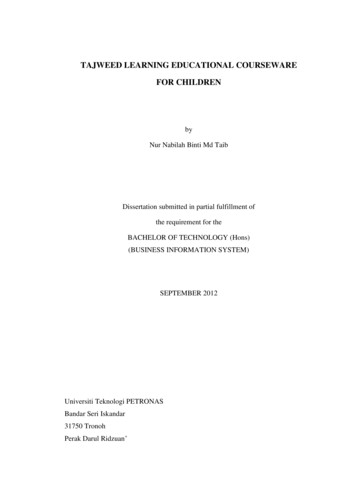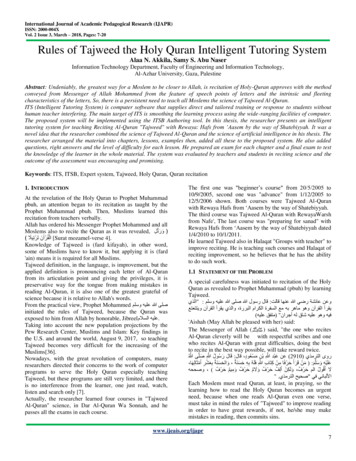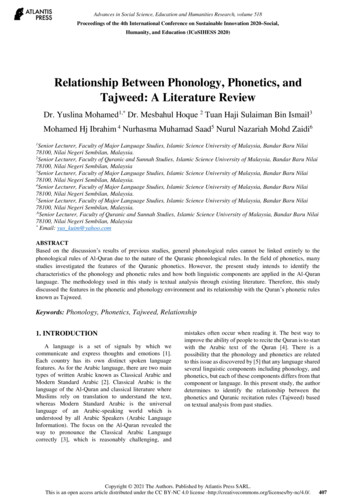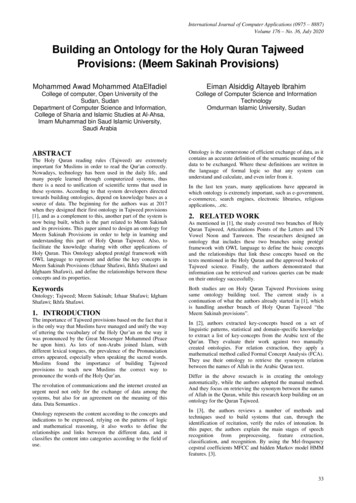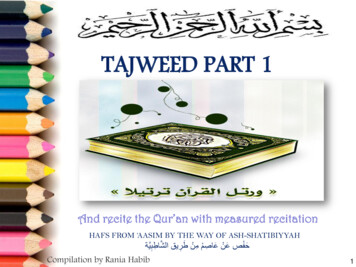
Transcription
TAJWEED PART 1And recite the Qur’an with measured recitationHAFS FROM ‘AASIM BY THE WAY OF ASH-SHATIBIYYAH َح ْفص َعنْ َعاصِ ْم ِمنْ َط ِرٌق ال َّشاطِ ِبٌَّة Compilation by Rania Habib1
Index1-The Qur’an.2-Brief notes on the Ten Qira’at.3-What is Tajweed?4-Mistakes in Tajweed .4- Seeking refuge and Saying the Basmalah5-Articulation point of letters (Makharij) .6-Characteristics of letters .7-Tafkheem and Tarqeeq.2
SOURCESUsed in parts 1 & 2 Tajweed Rules of the Qur’an by Kareema Carolwww.about Tajweed.comChart of the ten Qira’at copied from www.Tajweed.comAttajweed Almusawar By Dr.Ayman SuaiedPictures Attajweed almusawar , www.heesbees.wordpress.comAudios of Shaykh Al-Husary, Shaykh Ayman Suwaied, & Tardeed- Makharij ,Brother Wissam Shareef ,shaikh Furqan (lesson isti’adha and basmalah),Brother Mustafa Isma’il (reading words)Quranic webinar (heavy letters) .www.tardeed.com (Alqa’idah An-nouraniyah)Parts of introduction from sites as islamic-awareness, idealmuslimahReach the goal via tajweed rules by Maha RashedTajweed Course MakharijTayseer Ar-rahman bookGuide of the princibles of Tajweeed by Khalifa EzzatTajweed rules for Qur’anic recitation by Hafs AlGazziJaza Allah Khyran each one helped in revising this book .3
The Qur‟an, the last revealed word of Allah, is the primarysource of every Muslim‟s faith and practice. It deals with allthe subjects which concern human beings: wisdom, doctrine,worship, transactions, law, etc., but its basic theme is therelationship between Allah subhanahu wa ta‟ala and Hiscreatures. At the same time, it provides guidelines anddetailed teachings for a just society, proper human conduct,and an equitable economic system.Not one word of its 114 surah(s) (or chapters) has beenchanged over the centuries. The Qur'an is in every detail thesame unique and miraculous text that was revealed toMuhammad over fourteen centuries agoAllah subhanahu wa ta‟ala says:ُ الذ ْك َر َوإِ َّنا لَ ُه لَ َحاف ِّ إِ َّنا َنحْ نُ َن َّز ْل َنا )9( ون َ ِظ Verily We: It is We Who have sent down the Dhikr (i.e. theQur'an) and surely, We will guard it (from corruption).Al-Hijr :94
The Qur‟an consists of 114 surah Beginning with surat alfatihah andending with surat AnNas .All of the suwar(plural of surah meanschapters) in the noble Qur‟an are grouped together into what arecalled ajzaa‟ (plural of juz‟ or part) .A juz‟ is one of the thirty parts inthe noble qur‟an ,each juz‟ is further divided into ahzab (plural ofhizb )each equivalent to half a juz‟ ,there are two Ahzab in each juz‟which means 60 Hizb in the entire Qur‟an.(Indeed those who recite the Book of Allah (this Qur'an), andperform As-Salat (Iqamat-as-Salat), and spend (in charity) out ofwhat We have provided for them, secretly and openly, hope for a(sure) trade-gain that will never perish. That He may pay them theirwages in full, and give them (even) more, out of His Grace. Verily! Heis Oft-Forgiving, Most Ready to appreciate (good deeds and torecompense) (Qur‟an 35:29,30)The messenger of Allah salla Allah alihi wa sallam said “recite theQur‟an ,for it will come on the day of judgment as an intercessor forits companion “ (Muslim).Also he said salla Allah alihi wa sallam“ Whoever recites a letterfrom the book of Allah ,will get a good deed , and good deed isrewarded tenfold .I am not saying that alif lam meem are counted asone letter ,rather alif is counted as one letter ,lam is counted as oneletter and meem is counted as one letter.”(bukhari and muslim)5
- Reciting the Quran is the duty of every good Muslim on a dailybasis. Whether in congregation or separately, every literatebelieving man, woman and child should be reading, learning andsharing from the Book of Allah.ُ ْ ض ْن ًكا َو َنح ُ ) َقا َل َربِّ لِ َم َح َشرْ َتنًِ أَعْ َمى َو َق ْد ُك ْن 124( ش ُرهُ ٌَ ْو َم ْال ِق ٌَا َم ِة أَعْ َمى ت َ ض َعنْ ِذ ْك ِري َفإِنَّ لَ ُه َمعٌِ َش ًة َ َو َمنْ أَعْ َر )126 ( ك ْال ٌَ ْو َم ُت ْن َسى َ ِ ك آَ ٌَا ُت َنا َف َنسِ ٌ َت َها َو َك َذل َ ك أَ َت ْت َ ِ ) َقا َل َك َذل 125( بَصِ ٌرً ا Surah Ta-Ha : (124,125,126)-But whosoever turns away from My Reminder (i.e. neither believesin this Qur'an nor acts on its orders, etc.) verily, for him is a life ofof (hardship, and We shall raise him up blind on the DayResurrection. (124)- He will say:"O my Lord! Why have you raised me up blind, while Ihad sight (before).“ (125)- (Allah) will say: "Like this, Our Ayat (proofs, evidences, verses,lessons, signs, revelations, etc.) came unto you, but youdisregarded them (i.e. you left them, did not think deeply in them,and you turned away from them), and so this Day, you will beneglected (in the Hell-fire, away from Allah's Mercy). (126)Note that the Qur‟an was revealed to Muhammad Salla Allah AlihiWa sallam in Arabic only. So, any Qur‟anic translation, either inEnglish or any other language, is neither a Qur‟an, nor a version ofthe Quran, but rather it is only a translation of the meaning of theQur‟an. The Qur‟an exists only in the Arabic in which it was6revealed.
Among the next generation of Muslims referred to as Tabi‟oon,there arose many scholars who learned the various methods ofrecitation from the Sahabah (companions) and taught them toothers. Centers of Qur'anic recitation developed in al-Madeenah,Makkah, Kufa, Basrah and Syria, leading to the evolution ofQur'anic recitation into an independent science. By mid-eighthcentury CE, there existed a large number of outstanding scholarsall of whom were considered specialists in the field of recitation.Most of their methods of recitations were authenticated by chainsof reliable narrators ending with the Prophet peace be upon him .Those methods which were supported by a large number of reliablenarrators on each level of their chain were called Mutawaatir andwere considered to be the most accurate.Qira'at refers to the various manners of reciting the Qur‟an Eachqira'ah is named after the Qari‟ who was famous in reciting in thatmanner.- There are 10 authentic Qira'at. For a qira'at to be authentic thereare very detailed rules.7
In the sixth century of the hijrah ,a shaykh of the science ofTajweed, Abu al-Qasim ash-Shatibi Alandalusi , Imam Shātibī wasborn in Shātibah in 538 A.H. ,Ibn ,al-Jazarī and many othersnarrate that he was born blind, there are reports which mention thatImām Shātibī was not born blind, but rather that he became blindlater in his life. It is reported that if someone who did not know thatthe Imam was blind sat down to converse with him, he would neverrealize that the Imam was actually blind. became so prominent thatscholars of recitation all embraced his Shatibiyyah which he called( Hirz alamani wa wajh attahani )in which he formulated the featuresof the seven Qira‟at in 1173 verses of poetry. He died at the age of52 in (590 AH).After him scholars of this science succeeded one another in everyera carrying the banner of the glorious Qur‟an ,safeguarding itssciences, both in term of recitation and application .They spenttheir lives serving it in different ways.In time another great scholar appeared ,Imam Muhammad IbnAljazari ash-shafi‟i (751-833 AH) ,who had numerous followers andwrote many books ,The most prominent of which was an-Nashr filQira‟at al‟Ashr (an-Nashr in the 10 Qira‟at).He also composed Tajweed almuqaddimah fima ala qari‟hi anya‟lamah (an introduction to what the reciter ought to know).8
The ten Qira’at from the way of Ash-Shatibiyyah and Ad-Durrahَّ القِراءات العشر من طرٌق ال شاطِ ب ٌَّهة والد َُّّرة The seven Qira’at from the way of Ash-shatibyyahَّ القراءات السبع من طرٌق ال شاطِ ب ٌَّة The seven ImamsEach Imam has 2 narrators( ( راوي , or two known imams who have passed on reading from a particularImam .There can be significant differences in the reading between one narrator and another dependingon what their imam taught them.All ways are authentic readings of the Qur’an and are part of therevelation.Note: Ad-Doori ( (الدُّوري is a narrator for two different Qira’ah and Khalaf ( (خلف is a narrator forthe Qira’ah of Hamzah( (حمزة in addition to the fact that there is a Qira’ah named after him in the threeQira’at in the second out line below . ابن كثٌر أبو عمرو البصري نافع حمزة عاصم ابن عامر ً الكِسائ Alkisa’ee الدُّوري AdDooriHamzah اللٌث (أبو ) الحارث AlLayth َخ ََّّلد َخ َلف KhalladKhalafAasim حفص Hafs ابن ذكوان شعبة Shu’baIbndhakwanIbnKatheer’Abu AmrAlbasryIbn Amir هشام Hishamً السوس Assoosi الدُّوري AdDooriNafi’ قنبل البزي ورش قالون QunbulAlbuzziWarshQaloonThe three Qira’at from the way of Ad-Durrah القراءات السبع من طرٌق الد َُّّرة ال ُمضٌة The Three ImamsEach Imam has 2 narrators ( ( راوي , or two known imams who have passed on reading from aparticular Imam . خلف Khalaf إدرٌس Idrees ٌعقوب Ya’qoob إسحاق Ishaq َر ْوح Rawh أبو جعفر Abu-Ja’far ُر َوٌس Ruways سلٌَمان ابن ج َّماز ُSulayman ibnJammaz عٌسى ابن وردان ‘Isa ibn Wirdan9
These days about 90% of the world recites Hafs an Aasim , and about 3%Warsh an Nafi‟,7%Qaloon an Nafi‟, 3%Ad-Doori an Abu Amr and 1%Ibn Katheer-The Tajweed rules in this book according to riwayah Hafs „AnAasim by the way(tareeq) of Ash-Shatibiyyah.) ) َح ْفص َعنْ َعاصِ ْم ِمنْ َط ِرٌق ال َّشاطِ ِبٌَّة -Imam „Aasim :„Aasim Ibn Abee an-Najud Al-Kufi and was called Abo Bakr(d.127 AH) was the shaykh of recitation in Kufa and one of thescholars of the Tabi‟een (the generation immediately following thatof the prophet salla Allah alihi wa salam and his companions RadiaAllahu anhum )„Aasim isnad (chain of transmission)in recitation goes back toAbdullah Ibn masud and Ali Ibn Abi Talib Radia Allahu anhuma-Imam Hafs:Hafs Ibn Sulayman Ibn Almughirah Ibn Abi Dawud Alghadiri AlasadiAlKufi born 90 Al-Hijrah (d.180 AH) was a companion and student ofAasim .He studied and perfected recitation with Aasim and scholarsacknowledged his talents as an Imam of recitation .He had manyfollowers who went on to become scholars in this science.10
What is Tajweed?1. DEFINITION: LINGUISTIC DEFINITION: „Proficiency‟ or Betterment) (التحسٌن . APPLIED DEFINITION: Articulating every letter fromits articulation point and giving the letter its rightsand dues of characteristics.Rights of the letters ) (حق الحرف are its requiredcharacteristics that never leave it. The dues of theletters ) (مستحق الحرف are its presented characteristicsthat are present in it some of the times, and notpresent at other times. i.e. the madd, idgham2. ITS FORMATIONThe words of the Glorious Qur'an and some saidHonorable Hadiths also.3. ITS FRUITSIt preserves the tongue from mistakes in pronunciation of11the Glorious Qur'an during reciting.
What is Tajweed? (cont.)4. ITS PRECEDENCEIt is one of the most honored of sciences and one of thebest of them due to its relation to Allah‟s words.5. ITS PLACE WITHIN SCIENCEIt is one of the Islamic Law sciences that are related to theGlorious Qur'an.6. ITS FOUNDERThe rule setter from the practical point of view is theMessenger of Allah (SAWS/Allah‟s peace be uponhim) because the Qur'an was revealed to him from Allah,the most High, with tajweed, and he, was instructed on itfrom the Trust worthy, Jibreel (A.S/May Allah‟s peace beupon him) and taught it to his companions, who thentaught it to their followers and so on until it came to us bythese chains. The rule setters from the scientific point ofview are the scholars of Qur'anic sciences, such as12Abu 'Ubaid Al-Qasim bin Sallaam
What is Tajweed? (cont.)7. ITS PRECEPTKnowledge of tajweed is Fardh Kifayaah فرض كفاٌة , a groupof people who are enough for the Muslim community mustknow it, and its application is Fardh „Ain فرض عٌن , requiredby all Muslims (men and women) who have the completeQur‟an or part of it memorized, even if only one surah.8. REASON FOR ITS RULEGuarding the Glorious Qur'an and preserving it fromdistortion. The Arabs mixed with non-Arabs after thespread of Islam, and the Muslims feared that the Arabtongue would become corrupted with this intermixing .Itthen became mandatory for rules to be put down thatwould preserve the recitation of the Qur'an from mistakes,and guarantee the reader of the Qur'an integrity ofpronunciation.13
What is Tajweed?(cont.)9. ITS PRINCIPLEThe knowledge of tajweed is contingent on four matters:I. Knowledge of the articulation points of the letters.II. Knowledge of the characteristics of the letters.III. Knowledge of what rules change due to theorder/sequence of letters.IV. Exercising the tongue and a lot of repetition.14
Mistakes/Errors in TajweedMistake (Lahn) َلحن The scholars have divided the types of mistakes onemight fall into when reciting the Qur‟an into two types : َل ْحن ً لحن خف HIDDEN MISTAKESً لحن جل CLEAR MISTAKES15
ً لحن جل ً لحن خف CLEAR MISTAKESHIDDEN MISTAKESThe ruling on Hidden/ unobviousis lighter and the recitation of aperson falling into this type ofmistake is regarded as lacking incompleteness. A mistake that although does notchange the meaning of Quranicwords but the beauty of thewords diminishes Reading against the rules ofdifferent letters falls under thiscategory. This mistake is “makrooh”(disliked) Also it could be Haramif done intentionally.Examples : -To overlook the rules ofthe thick / full mouth (tafkheem)letters and the thin / empty mouth(tarqeeq) letters. Not to adhere to the rules ofith'har, idghaam and ikhfaa intheir respective places whilst16reciting the Qur'an. The Clear mistakes must beavoided by all and to avoidthem one must know the rulesof Tajweed.If a person falls into the ClearMistakes, this is considered asin and Ibn Taymiyyah evenregarded it undesirable for aStudent of Knowledge (i.e.someone who knows Tajweed)to pray behind a person whomakes clear Mistakes in theirSalaah.Very Obvious and can be feltChanges the meaning ofQuran‟s WordsMust Avoid it at every CostThese mistakes are Haram
TYPES OF ً لحن جل 2. Adding aletter1. Changinga letter7. Adding orDroppingShaddah3. Dropping aletterً لحن جل Clear mistake4. Changing aharakah(vowel)5. ChangingMutaharik tosukoon6. ChangingSakeen toMutaharik17
Seeking refuge and Saying the Basmalah االستعاذة والبسملة AL-ISTI’ADHA WAL BASMALAH1- Al- ISTI‟ADHA (seek refuge) االستعاذة Linguistic Meaning: Seeking Refuge or ProtectionApplied Meaning: A statement by which one seeks shelter throughAllah (SWT) from Shaytaan before reading Quran.Allah in the Qur‟an said:(and when you read the Qur‟an seek refuge with Allah from therejected Satan) An-Nahl 98.18
WAYS OF ISTI’ADHA(Seeking refuge)SilentlyLoudly-If the reader isreading alone.-If one is about topray the seekingrefuge is done silently.-If the reading is doneby turns, except thefirst reader everybodyelse does it silently.-If the reader reads theQur’an loudly andothers are present whowill be able to hear therecitation.-If the reading is doneby turn (as in Qur’anclass room situation)the first reader readisti’adha loudly.-If the reading is cut off by coughing, sneezing, or by talk referringto the reading or meaning of the verses, then there is no need forrepeating the seeking refuge.-If the reading is cut off by work or normal conversation, .etc.then the seeking refuge should be repeated before beginning toread the Qur‟an again.19
Al-BASMALAH ا ْل َب ْس َملة The “Basmalah” is the saying of ٌِم ِ ِب ْس ِم َّ من َّ هللا ِ الر ْح ِ الرح “ In the Name of Allah the MostBeneficent & Most Merciful”It is necessary to read it before the beginning of every surah of theQur'an with the exception of "At-Tawbah" which is also called“Baraa‟ah.”- Ways of Seeking refuge when starting recitation with thebasmalah and with the beginning of a surah:If the reader wishes to start his reading at the beginning of a surah,he needs to seek refuge, say the basmalah and then start recitingthe surah. There are four ways of doing this.20
Four Ways of Seeking refuge whenstarting recitation with the basmalahand with the beginning of a surah1-Cutting all three off from each other.Meaning seeking refuge, stopping, saying the basmalah, stopping,then starting the surah.Example: starting surat Al-Fatihah (audio)2-Joining all three with each otherSeeking refuge, saying the basmalah, and starting the surah all inone breath without stopping.21
3-Joining the basmalah and the beginning of the surah.This means seeking refuge, then stopping, then saying thebasmalah and the beginning of the surah in one breath.4-Joining seeking refuge with the basmalah.This means the seeking refuge and the basmalah are joined with onebreath, then the reader stops then starts the surah.Note: In the middle of the surah say “Isti’adha”, then stops then recite the Ayah,Or join Isti’adha with the Ayah.But if this ayah starts with Allah or His attributes or Muhammad(Peace be upon him), then it should not be joined with “Istiadha” alone.22
The Basmalah between two surahswe read the basmalah before starting the next consecutive surah whenreading the Qur‟an, except between Al-Anfal and At-Tawbah. There are fourways of completing a surah and continuing on reading to the next surah withthe basmalah in between them.Three of them are allowed, and one not allowed.1-Cutting off all from each otherThe reader finishes the surah, then stops and takes a breath, readsthe basmalah, stops and takes a breath, then reads the beginning ofthe next surah.Firstverse ofnextsurahBasmmalah2-Joining all of them togetherThe reader ends the surah, joining it with the appropriate vowelswith the basmalah, continuing with the same breath the reader thenjoins the basmalah with the beginning of the next surah.BasmmalahFirstverse ofnextsurah23
3- Joining the basmalah with the beginning of the surahIn this way the reader finishes the last verse of the surah, stopsand takes a breath, then reads the basmalah joining it in thesame breath and proper vowels with the beginning of the nextsura.BasmmalahFirstverse ofnextsurah4- Not Allowed: Joining the basmalah with the end of the surah, thenstopping, then starting the next surah.This incorrect way leads the listener to imagine that the basmalah is thelast aayah of the surah that was just finished. Here, the reader wouldjoin the end of the surah with the basmalah, then stops and takes abreath, then starts reading the next surah. This is not allowed.24
WAYS OF CONNECTING TWO SURAHSWITH BASMALLAH THAT ARE NOTCONSECUTIVE1- Cutting of allThe reader finishes the surah, then stops and takes a breath,reads the basmalah, stops and takes a breath, then reads thebeginning of the other surah.2- Joining the Basmallah with the beginning of the other Surahthe reader finishes the last verse of the surah, stops and takes abreath, then reads the basmalah joining it in the same breathand proper vowels with the beginning of the other surah.25
WAYS OF CONNECTING BETWEENAL-ANFAL AND AT-TAWBA1- The reader finishes the surah,of Al-Anfal then stops and takes abreath, then reads the beginning of surat At-Tawba (withoutBasmallah).2- The reader finishes the surah,of Al-Anfal then stops withoutbreath (sakt which is slight pause without breathing) then reads thebeginning of surat At-Tawba (without Basmallah).3- The reader will join the last verse of surat Al-Anfal withoutstopping in the same breath and proper vowels with thebeginning of surat At-Tawba.26
27
ARTICULATION POINT OFLETTERS (MAKHARIJ)28
ARABIC LaamWaawYaaHamzahHaWatch for proper pronunciation of the letter:http://www.youtube.com/watch?v nALCUgkKkyE#t 2729
DIFFERENT ARTICULATIONPOINTS30
CLASSIFICATIONARTICULATION POINTS31
TYPES OF ARTICULATIONPOINTSARTICULATION POINTSSPECIFIC ARTICULATIONPOINT Relies on specific place of theareas of the tongue, throat orlips.APPROXIMATE ARTICULATIONPOINT Does not rely on specificplace of the areas of thetongue,throat or lips.The approximatearticulation point isapplied to the lengthenedletters that come from theempty space in the mouthand throat.32
17 ARTICULATION POINTS33
AL- JAWF الجوف The empty space in themouth and throat is aplace and an articulationpoint at the same timeThe three madd letters (lengthened letters) originates fromthis non-specific area, these letters‟ finish with the stoppingof the sound (That stops with the air)These letters are : ألف Alif واو Waw ٌاء Yaa34
These three madd letters do not have a specific space that theyfinish at like other letters do, Instead these letters finish withthe stopping of the sound.The ya' with sukoonpreceded by a letterwith kasrahThe wow with sukoonpreceded by a letterwith DammahThe Alif with a sukoonpreceded by a letterwith Fathahِ ُنـو contains the three types of madd.The word حٌـهـَا 35
AL-HALQ الحلق (THE THROAT)There is in the throat threearticulation points for six lettersThese three areas are:Adnal halq ( ( (أدنى الحلق closest part)Wasatal halq ( (وسط الحلق Middle partAqsal halq ( (أقصى الحلق Deepest part خ غ ح ع 36 هـ ء
The deepest part of the throat ( أقصى الحلق means the farthestpart from the mouth and closest to chest) from here twoletters are articulated ء هــ .The middle part of the throat وسط الحلق where two lettersemerge ع ح The closest part of the throat ( أدنى الحلق means the closest to themouth) from here two letters emerge غ خ makharij-videos.html37
THROAT LETTERS WITH VOWELSFATHAH, KASRAH & DAMMAH38
غخ are from letters that have Tafkheem or from heavy letters.What is TafkheemThis lesson of velarization and attenuation (Tafkheem andTarqeeq) will be explained in details later but now in brief.Tafkheem: Fattening-ThickeningIts applied definition: It is a heaviness that enters the bodyof the letter, so that the mouth is filled with itsreverberation (echo).The method of making a letter have the characteristic oftafkheem is: elevating the posterior tongue to the roof ofthe mouth (soft palate), creating more space between theroof of the mouth and the bottom of the mouth, andfocusing the pressure of the letter to the roof of the mouth.1. Letters that always have tafkheem. These are theseven letters in the group ) خص ضغط قظ (خ ص ض غ ط ق ظ )these are called the tafkheem letters (heavy letters).39
There are differences in degrees of tafkheem according tothe letter‟s characteristics, and the strength or weakness ofthese characteristics.The ranking of these letters from the strongest ط ض ص ظ ط ض ص ظ ق غ خ are stronger due to the adhesion of the tongue to the roof ofthe mouth in conjunction with the elevation of the tongue.2. Letters that have tafkheem sometimes and tarqeeq othertimes.a) lengthened Alif ( األلف المدٌة The alif is known to follow theletter preceding it as to tafkheem or tarqeeq).b) Laam الالم Pronouncing heavy Laam of The Exalted Nameof Allah is one of the temporary Qualities (Tafkheem).Explained in details later in shaa‟Allah.c) Raa ( الرا has 8 cases in which it has tafkheem, 4 cases inwhich it has tarqeeq, and 2 cases that allow eithertafkheem or tarqeeq). Explained in details later inshaa‟Allah.40
What is TarqeeqThe rest of Arabic alphabet always have Tarqeeq.Tarqeeq: ThinnessIts applied definition:It is a thinness that enters the body of the letter, so themouth is not filled with its reverberation (echo).41
AL-LISAAN اللسان (THE TONGUE)42
CLASSIFICATION OFTEETHTo study the Tongue Makhraj, you have to know about yourteeth.43
ك DEEPEST PART OF THETONGUEFrom the deepest part ofthe tongue what liesopposite to it of roof ofthe mouth (the soft andthe hard palate).From the deepest part ofthe tongue what liesopposite to it of roof ofthe mouth (the softpalate). ق 44
ق ك The kaf is under the qaf a little, meaningcloser to the mouth and farther from the throatthan the Qaf.WITH HARAKATH:45
MIDDLE OF THETONGUEThree letters are articulated from here, they are: ي ش These letters are emitted from the middle ofthe tongue and the roof of the mouth that liesopposite to it. ج 46
WITH HARAKATHFATHAH, KASRAH & DAMMAH47Non lengthened yaa
ل THE SIDE OR EDGE OF THETONGUE ض ض Touching areaFront edgesPressing areaPosterior edgesThe area that isoccupied letter Daad ض from the edges of thetongue48
ض It is articulated from oneof the sides or edges ofthe tongue and what liesopposite to of the uppermolars left or right, it canbe also from both sides atthe same time.This is one of the most difficult articulation pointsWATCH:https://www.youtube.com/watch?v bw8W-QW3PuU49
ل This letter‟s articulation point is from the nearest part of thesides of the tongue and the end of its tip, and what liesopposite to it of the gums of the first two upper premolars,the two upper canines, the two upper lateral incisors andthe two upper front incisors.Its articulation point is the front edges of the tongue,whereas the ض is from the posterior edges of the tongue.50
HEAVY & LIGHT ل Light LaamHeavy LaamRules for The Laam in the Name of Allah1. If there is a Fatha or a Dhamma before the word ofAllah or Allahum, then laam in Allah will be heavy.2. If there is a kasrah before the word Allah, then theLaam in Allah or Allahum will be light.3. If the reader starts reading with the name of Allah, thenLaam in Allah or Allahum will be heavy. ) (اللهم) & (هللا .51
د ز ط ص ن س ت THE TIP OF THETONGUE ر ظ ذ ث It has 5 articulation points with 11 Letters52
ARTICULATION POINT OF ن It is articulated from the tip of the tongue and what liesopposite to it of the gums of the two top front incisorsslightly beneath the articulation point for the laam.Sharing ghunnah (nasalization) during pronunciationfrom the Nasal cavity ) )الخٌشوم .53
Note: When the noon is hidden the articulation point changesfrom the tip of the tongue to near the articulation point ofthe letter (letter follows noon sakinah) that is causing theikhfaa (Hiding) of Noon sakinah. In case of idgham (noon sakinah merged in the letterfollowing it) changes its articulation point from the tip ofthe tongue to the articulation point of the letter it ismerged with.54
ARTICULATION POINT OF ر This letter is emitted from thetip of the tongue with thegums of the two front topincisors after the makhraj ofNoon.The tip of the tongue need to strike the gums to producethis sound correctly. There should be no trilling of the55tongue when pronouncing this letter.
This space let part of the soundpass when we pronounce ر .Also this space prevent trilling ofthe tongue while pronouncing.Light RaaHeavy RaaRa ر letter sometimes has tafkheem and sometimestarqeeq according to its case and these cases will beexplained in another lesson in shaa' Allah.56
ARTICULATION POINTOFThese letters are pronounced from the topside of the tip of the tongue and the gum line(root) of the two front upper incisors.The gum line is exactly where the gum meetsthe teeth. ت ط د ط د ت 57
This group is called الحروف النطعٌة due to their articulationposition close the elevated area above the gums. ط It is a letter that hastafkheem (heaviness), A fargreater portion of the tongueadheres to the roof of themouth when pronouncingthis letter It is the strongestof all the letters of the Arabiclanguage.58
ARTICULATION POINT OF ص ز س These three letters are emitted from the tip of the tongue and the plates ofthe two lower incisors, the sound passes above the two front lower incisorsbetween the upper and lower incisors. There is a little space left in betweenthe tip of the tongue and the plates of the teeth when pronouncing these59letters.
-N.B: The term “plate” refers to the long axis of the tooth, and inthis case, the long axis that is on the internal side, rather than theexternal side of the teeth.-These letters called الحروف األسلٌة due to their emerging from the tipof the tongue, also called letters of الصفٌر , which means “whistle”.They are called because they accompany with whistle type soundwhen they are emitted properly. ص It is one of the tafkheem (heavy) letters, and it also has thecharacteristic of Adhering. If it is not made heavy enough, it soundsjust like, or very close to س . The elevation of the tongue with the ص is60not at the articulation area, but rather with the back of the tongue.
ARTICULATION POINT OF ظ ذ ث These letters are articulated from between the tip of the tongue(from the top side of the tip) and the edges of the two top frontincisors.Care should be taken to make sure the top of the tip is reallycolliding or separating (depending whether there is no vowel or a61vowel) with the edges of the teeth and not the plates of the teeth.
ظ is one of the tafkheem (heavy) lettersThe back part of the tongue rises up to the roof makes the lettersound heavy.These three letters are grouped as الحروف اللثوٌة because theirarticulation point is some what close to the gums.62
WITH HARAKATHFATHAH, KASRAH & DAMMAH63
AL-SHAFATAYN الشفتٌن و (THE TWO LIPS) ف م ب 1-The Faa is articulated between theinside of the lower lips and the tips ofthe two front incisors. ف 64
ب The Baa is articulated fromclosing the two lips together,stronger closing than meem.65
م The meem is articulated from closing the two lips together,sharing ghunnah (nasalization) from nasal cavity الخٌشوم .66
و The un lengthened wow isarticulated by forming a circleof the two lips.67
WITH HARAKATHFATHAH, KASRAH & DAMMAH68
AL-KHAYSOOM) التجوٌف األنفً )الخٌشوم THE NASAL CAVITY69
The Nasal cavity (passage):The hole in the nose that continues back towards inside the mouth.Ghunnah is articulated from this place.Ghunnah is a nasal sound not a letter written coming from the nasopharynxwithout any influence from the tongue. If you hold your nose closed you willnot be able to produce the ghunnah sound, but the letters Noon and Meemthemselves that have this associated sound with them are not articulatedfrom the nose.Ghunnah is a characteristic of Noon and Meem prevalent more when
Tajweed Rules of the Qur'an by Kareema Carol www.about Tajweed.com Chart of the ten Qira'at copied from www.Tajweed.com Attajweed Almusawar By Dr.Ayman Suaied Pictures Attajweed almusawar , www.heesbees.wordpress.com Audios of Shaykh Al-Husary, Shaykh Ayman Suwaied, & Tardeed- Makharij , Brother Wissam Shareef ,shaikh Furqan (lesson isti'adha and basmalah),
